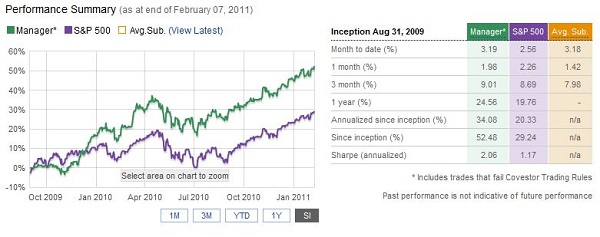 Author: Andy Schornack
Author: Andy Schornack
Covestor model: Financial Services
Disclosures: Long RNST

In keeping with the four previous months, January was another positive month for the investment portfolio. The model has continued to progress forward with the market, and I am very satisfied with its positioning as we move further into 2011.
During the past month, I added Renasant Corporation (NASDAQ: RNST) to the portfolio and sold the entire position in Goldman Sachs Preferred D Shares (NYSE: GS-D). Renasant is a regional bank headquartered out of Tupelo, MS with over 80 offices and $4.5 billion in total assets (source: Renasant press release . It provides banking, mortgage, insurance and financial services in Mississippi, Tennessee, Alabama and Georgia. The bank pays a dividend of $0.17/share per quarter, yielding 4.26% as of the close of trading on February 3, 2011 (Yahoo Finance). The bank’s underwriting has performed well through the crisis and the bank recently completed an FDIC assisted transaction that provided entry into the North Georgia market. I believe solid underwriting, good dividend history, growing earnings, and a growing asset base provide for additional upside on this investment. To make room in the portfolio, I sold the Goldman Sachs Preferred D shares. My thesis for that position played out well over the past several months. Moving forward, I see more capital appreciation opportunity with a comparable yield in Renasant.
Overall, my bullishness on the regional bank sector grows, as I am seeing continued stabilization in the commercial real estate market and growth among my commercial loan customers. I am not yet bullish on the overall real estate market, but believe it is stabilizing and creating a floor.
The manner in which financial institutions reserve for loss is often missed or poorly articulated by the news media. Specific accounting and regulatory guidelines and rules such as FAS 114 and FAS 5 drive reserve models for community and regional banks. These guidelines, coupled with aggressive appraisal valuations, drive banks to reserve accordingly against potential losses in the loan portfolio. When coupled with fairly non-existent loan growth and in many cases declining loan balances over the past couple of years, the better financial institutions have been able to build a solid reserve foundation as well as identify the weakest credits in their portfolio, so as the economy improves additional reserves should be minimized, weak credits will get stronger, and earnings should move higher to more normalized levels. (I consider a relatively conservative level of 1% Return on Assets and 10% Return on Equity as a base standard.) Banks are not necessarily “releasing” reserves/loan loss provisions; rather, they are seeing less risk in the portfolio and/or have already reserved accordingly for the existing risk. Let me reiterate: if the pool of loans is not growing or is declining, the need to increase reserves on the same pool of loans is driven by the deterioration in the individual, business, and/or collateral of the repayment source. If the economy is improving, reserves in this case will be more stable and additional reserves will be more limited.
As always, the portfolio maintains a cash position that allows for flexibility on market entry opportunities. Over the next month to two months, I will continue to revisit positions in the portfolio and may add/subtract investments with the total number of investments remaining ideally in the 10-15 range. Currently we are slightly outside this range on the high side, which I don’t see as a negative. The target portfolio yield is 3% and currently the portfolio provides for a monthly dividend stream. This is driven by the composition and historical timing of dividends from the different stocks in the portfolio and could change at any time.
Thanks for subscribing.



